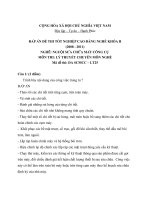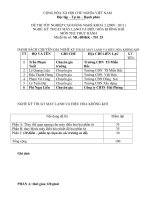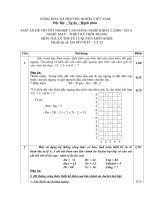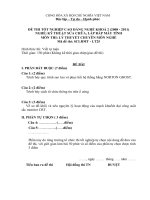25 shi asymmetric epoxidation reaction
Bạn đang xem bản rút gọn của tài liệu. Xem và tải ngay bản đầy đủ của tài liệu tại đây (739.79 KB, 5 trang )
Myers
Chem 115
Shi Asymmetric Epoxidation Reaction
Reviews:
Examples:
Wong, O. A.; Shi, Y. Chem. Rev. 2008, 108, 3958–3987.
1. Effect of smaller R1 (also known as "T-branch"; phenyl groups can be considered smaller than
methyl).
Shi, Y. Acc. Chem. Res. 2004, 37, 488–496.
Frohn, M.; Shi, Y. Synthesis 2000, 14, 1979–2000.
H3C
General Transformation:
H3C
R1
O
R3
R2
O
CH3
O
R1
R2
O
R3
• Useful for epoxidation of trans-disubstituted olefins (ketone 1), trisubstituted olefins (ketone 1),
conjugated cis-disubstituted olefins (ketone 2, see p. 3), and styrenes (ketone 2, see p. 3).
Catalyst Conditions:
H3C CH
3
H3C CH
3
O
O
O
H3C
O
O
O
CH3
Spiro
R3
O R
3
R2
O
H3C
O
O
R1
R2
Planar
Higher ee's are observed with smaller R1 and larger R3 substituents.
98% ee
CH3
H3C H3C CH3
91% ee
3. Comparing the size of R1 and R3.
Ph
Ph
CH3
76% ee
CH3
CH3
97% ee
Wang, Z.-X.; Tu, Y.; Frohn, M.; Zhang, J.-R.; Shi, Y. J. Am. Chem. Soc. 1997, 19, 11224–11235.
Proposed Catalytic Cycle:
R1
R2
R1
O
R3
H3C
O
R3
O
CH3
HSO5–
O
R2
O
O
H3C
O
O
H3C
O
CH3
H3C
O
H3C
CH3
O
O
O
O
O
H3C
CH3
H3C
O
CH3
H3C
C10H21
86% ee
O
O
81% ee
CH3
76% ee
H3C
• Ketone 1 can be readily prepared from D-fructose ($15/kg) by ketalization (acetone, HClO4, 0
°C, 53%) and oxidation (PCC, 23 °C, 93%). L-Fructose can be prepared in 3 steps from
readily available L-sorbose.
• Ketone 1 can be used catalytically (20–30 mol %).
• Oxone (a commercial mixture of 2:1:1 KHSO5:KHSO4:K2SO4) is used as the stoichiometric
oxidant but H2O2/CH3CN can also be used (peroxyimidic acid is the proposed oxidant).
• Generally, the optimum pH for dioxirane epoxidation is 7–8. At higher pH, Oxone tends to
decompose. However, at pH 7–8 the Shi catalyst decomposes due to competing BaeyerVilliger reaction. By increasing the pH to 10.5 (by addition of K2CO3), the amount of ketone
used can be reduced to a catalytic amount (30 mol %) and the amount of Oxone can be
reduced to a stoichiometric amount (1.5 equiv), suggesting that at this pH the ketone is
sufficiently reactive to compete with Oxone decomposition.
• Dimethoxymethane (DMM) and CH3CN (2:1 v/v) solvent mixtures generally provide higher
ee's.
• Reaction temperatures range from –10 to 20 °C.
• It is proposed that the Shi epoxidation proceeds through a dioxirane intermediate and a spiro
transition state and that a so-called planar transition state is a main competing pathway. The
spiro transition state is believed to be electronically favored as a result of a stabilizing interaction
between an oxygen lone pair of the dioxirane with the !* orbital of the olefin.
O R
1
H3C
Ph
CH3
1
O
79% ee
2. Effect of larger R3 (also: "L-branch").
H3C
O
CH3
Ph
H3C
26% ee
oxone, pH 10.5, base
H2O, CH3CN
O
O
H3C
H3C
H3C CH3
O
SO42–
CH3
O
OH
O O
SO3–
CH3
O
O–
O
H3C
O
O
CH3
O
O
CH3
O O
SO3–
Soojin Kwon
1
Myers
Chem 115
Shi Asymmetric Epoxidation Reaction
Examples of Shi Epoxidations:
• Regioselectivity increases when either olefin of a 1,3-diene is trisubstituted. It is proposed that
the trisubstituted olefin prevents full conjugation of the diene due to A1,2 strain, causing each
olefin to present an individual steric or electronic environment, as if each were isolated.
Substrate
Ph
Product
O
Ph
Ph
O
O
O
CH3
TMS
Ph
O
1, Oxone, K2CO3,
CH3CN, DMM
TMS +
Ph
O
Ph
R
TMS
R
93%
41%
93%
94%
89%
Yield
ee
Ratio
R=H
31%
95%
1:1
R = CH3
77%
92%
14:1
O
Ph
CH3
95%
61%
Frohn, M.; Dalkiewicz, M.; Tu, Y.; Wang, Z.-X.; Shi, Y. J. Org. Chem. 1998, 63, 2948–2953.
O
n-C10H21
73%
Cl
Ph
O
Ph
ee (%)
R
O
Cl
Ph
Ph
Yield
n-C10H21
CH3
CH3
• Epoxidation of enynes occurs selectively at the C–C double bond.
Tu, Y.; Wang, Z.-X.; Shi, Y. J. Am. Chem. Soc. 1996, 118, 9806–9807
and Wang, Z.-X.; Tu, Y.; Frohn, M.; Zhang, J.-R.; Shi, Y. J. Am. Chem. Soc. 1997, 119, 11224–11235.
TMS
Ph
CH3
• Monoepoxidation of conjugated dienes favors the more electron-rich or less sterically hindered
olefin. The amount of catalyst used must be properly controlled (0.2–0.3 equiv) to prevent bisepoxidation. Vinyl silanes and allylic silyl ethers are deactivated towards epoxidation
(attributed to sterics and inductive deactivation, respectively).
1, Oxone, K2CO3,
O
TMS
Ph
CH3CN, DMM
CH3
64%, 94% ee
Cao, G.-A.; Wang, Z.-X.; Tu, Y.; Shi, Y. Tetrahedron Lett. 1998, 39, 4425–4428.
Wang, Z.-X.; Cao, G.-A.; Shi, Y. J. Org. Chem. 1999, 64, 7646–7650.
CH3
OTBS
H3C
CH3
25 mol % 1, Oxone, K2CO3
CH3CN, DMM
OTBS
H3C
O
• 1,1-Disubstituted epoxides can be synthesized enantioselectively by Shi epoxidation of
trisubstituted vinyl silanes followed by TBAF-mediated desilyation.
81%, 96% ee
CH3
H3C
H3C
CH3
OCH3
20 mol % 1, Oxone, K2CO3
CH3CN, DMM
65%, 89% ee
O
H3C
H3C
CH3
OCH3
TMS
1, Oxone, K2CO3
CH3CN, DMM
CH3
O
74%, 94% ee
Warren, J.D.; Shi, Y. J. Org. Chem. 1999, 64, 7675–7677.
TMS TBAF
82%
CH3
O
94% ee
Soojin Kwon
2
Myers
• A modified catalyst is useful for epoxidation of cis-disubstituted olefins and styrenes.
O
O
O
CH3
CH3
CH3
CH3
NBoc
O
O
H3C
• Enol esters can be used as substrates for the preparation of !-hydroxyketones in either
enantiomeric form.
O
O
Ph
Chem 115
Shi Asymmetric Epoxidation Reaction
H
2
Ph
O
O
CH3
66%, 91% ee
Ph
O
Ph
OH
90%
O
CH3
CH3
Ph
91% ee
H
Oxone, K2CO3, DME, DMM
O
K2CO3, MeOH
O
CH3
94% ee
195 °C, 0.5 h
82%, 91% ee
92%
The enantiomeric excess is generally high for cyclic olefins and for acyclic olefins conjugated with
an alkynyl or aromatic group.
O
Ph
Tian, H.; She, X.; Shu, L.; Yu, H.; Shi, Y. J. Am. Chem. Soc. 2000, 122, 11551–11552.
CH3
O
K2CO3, MeOH
CH3
Ph
OAc
OH
O
O
O
88% ee
NBoc
Zhu, Y.; Tu, Y.; Yu, H.; Shi, Y. Tetrahedron Lett. 1998, 39, 7819–7822.
O
O
H3C
O
CH3
O
2
• Kinetic resolution of racemic 1,3- and 1,6-disubstituted cyclohexenes can provide optically
enriched allylic silyl ethers.
Oxone, K2CO3, DME, DMM
100%, 81% ee
OTMS
Ph
Tian, H.; She, X.; Xu, J.; Shi, Y. Org. Lett. 2001, 3, 1929–1931.
Tian, H.; She, X.; Yu, H.; Shu, L.; Shi, Y. J. Org. Chem. 2002, 67, 2435–2446.
In both cases, it is proposed that the "-substituent of the substrate prefers to be proximal to the spiro
oxazolidinone.
O
NBoc
R"
R
O O 1
O
O
CH3 CH3
OTMS
Ph
OTMS
Ph
O
49% conversion
OTBS
96% ee
trans:cis >20:1
95% ee trans
OTBS
OTBS
35 mol % 1
O
O
35 mol % 1
Ph
70% conversion
Ph
99% ee
O
Ph
trans:cis 4:1
81% ee trans
Frohn, M.; Zhou, X.; Zhang, J.-R.; Tang, Y.; Shi, Y. J. Am. Chem. Soc. 1999, 121, 7718–7719.
Soojin Kwon
3
Myers
Chem 115
Shi Asymmetric Epoxidation Reaction
• The original Shi catalyst decomposes (via the Baeyer-Villiger pathway) faster than it reacts with
electron-deficient !,"-unsaturated esters. A second-generation catalyst, incorporating electronwithdrawing acetate groups, slows the Baeyer-Villiger decomposition.
H3C
O
Cryptophycin 52:
The Shi epoxidation system provided the desired epoxide in a 6:1 diastereomeric ratio, while
other epoxidation methods never exceeded a 2:1 ratio.
CH3
O
CH3
Ph
O
OAc
CO2Et
Cl
OH
73%, 96% ee
O
CO2Et
Ph
O
OCH3
CCl3
Applications in Synthesis:
Conditions
",! ratio
Ketone 1
m-CPBA
6.5:1
1.5:1
H3C
O
dihydroxylation
CH3
HO CH3
CH3
R
O
O
OH
CH3
O
1, Oxone, DMM,
CH3
H3C
CH3CN, H2O,
piperidine, DMF
pH 10.5, 0 °C, 1.5 h
79%
O
O
O
O
CH3
CH3
CH3
CSA, toluene, 0 °C, 1 h
31% (2 steps)
OH
CH3
OH
H3C
H
O
CH3 H
O
H3C
O
CH3
H3C
H3C
H3C
O
CH3
O
O
O
O
HN
CH3
CH3 O
NHFmoc
CH3
O
OH
OH
O
71% (2 steps)
CH3
CH3
88% ee
HO CH3
CCl3
DMAP, DCC, CH2Cl2
CH3
H 3C
73%
HN
NHFmoc
O
H3C CH3
H3C
Glabrescol:
asymmetric
O
O
Wu, X.-Y.; She, X.; Shi, Y. J. Am. Chem. Soc. 2002, 124, 8792–8793.
squalene
CH3
Conditions
HN
OH
AcO
O
O
O
CH3 H
O
H
O
O
CH3 H CH3 H
H3C
O
Cl
O
OCH3
CCl3
CH3
O
O
O
HN
N
O
H
H3C CH3
Cl
O
OCH3
Cryptophycin 52
CH3
originally proposed structure of Glabrescol
Hoard, D. W.; Moher, E. D.; Martinelli, M. J.; Norman, B. H. Org. Lett. 2002, 4, 1813–1815.
Xiong, Z.; Corey, E. J. J. Am. Chem. Soc. 2000, 122, 4831–4832.
Soojin Kwon
4
Myers
Chem 115
Shi Asymmetric Epoxidation Reaction
Thyrsiferol:
Octalactin A:
Post epoxidation, only one bromohydrin diastereomer cyclized to the bromotetrahydropyran. The
unreactive diastereomer was separated from the cyclization product and isolated in 30% yield.
CO2CH3
TBSO
Ph3P, AcOH
CO2CH3
TBSO
80 °C, 8 h
CH3
CH3
85%
H3C
30 mol % 1, Oxone
OAc
H3C
CH3
OTBS
CO2CH3
TBSO
1. Me3Al; H2O, –30 °C,
2 h, 82%
O
TBSO
CH3
2. TBDMSCl, Im, 23 °C,
2 d, 84%
(proposed)
HO
H
TBSO
CH3
OAc
H
Br
CH3
cat. CSA
CO2CH3
Et2O
50%
90–96% ee
O
O
H
Br
O
O
HO
H3C
farnesyl acetate
H3C
H3C
OTBS
H3C
O
2. catalyst 1, Oxone,
DMM, CH3CN, H2O,
pH 10.5, 58%
K2CO3, 0 °C, 6 h
45 %
1. NBS, THF, H2O, 67%
O
O
CH3
CH3 CH3
OH
CH3
CH3
CH3
H
OAc
H3C
H3C
OH
O
CH3
CH3
H
H
Br
OAc
OH
t-BuOOH, cat. Ti(O-i-Pr)4
(+)-diethyl tartrate, CH2Cl2
CH3
99%
Octalactin A
Bluet, G.; Campagne, J.-M. Synlett 2000, 1, 221–222.
H3C
H3C
H
Br
O
CH3
H
OAc
CH3
O
OH
>95% de
(proposed)
H3C
H3C
H3C
O
CH3
H
Br
McDonald, F. E.; Wei, X. Org. Lett. 2002, 4, 593–595.
O
HO CH3 H3C
H
H
O
H
O
HO H
CH3
HO CH3
H
Thyrsiferol
Soojin Kwon
5









